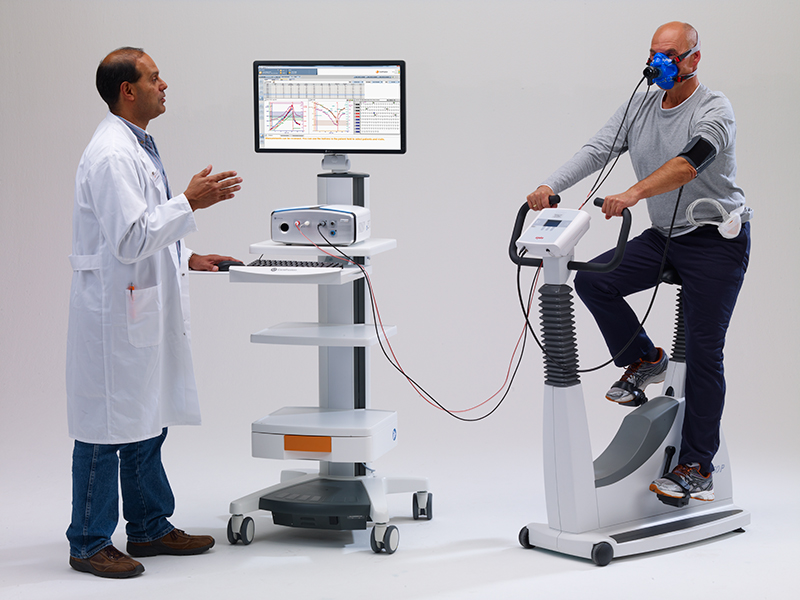What is CPET?
Cardiopulmonary exercise testing (CPET) is a specialized type of stress test that measures how much oxygen the body is using, how much carbon dioxide it is producing, breathing patterns, and heart function. Data are analyzed at rest, during exercise, and into recovery using advanced computerized systems. When integrated with standard variables measured during CPET, including heart rate, blood pressure, work rate, electrocardiography (ECG) findings, and symptoms, these data provide a comprehensive assessment of exercise tolerance and exercise responses [1]. CPET results can be used to prove or support claims of disability caused by chronic conditions, including Lyme and other tick-borne diseases.
Workwell Foundation is a California based fiscally sponsored program of United Charitable, a 501(c)(3) nonprofit organization. They have been conducting CPET with clinical populations for over 25 years, performing more than 3,000 tests. They specialize in the research and evaluation of disability impairment for myalgic encephalomyelitis/chronic fatigue syndrome (ME/CFS), fibromyalgia syndrome (FM), Lyme disease, and other pain/fatiguing conditions. Workwell faculty have been invited to present on the topic of CPET and fatigue and/or served in advisory capacities to numerous organizations including the U.S. Department of Health and Human Services (HHS), the Food and Drug Administration (FDA), the National Institutes of Health (NIH), the Centers for Disease Control and Prevention (CDC) and the National Academy of Medicine (NAM, formally Institute of Medicine). Their peer-reviewed research in this area is cited frequently in professional literature and other media.
In line with the most recent American Heart Association guidelines, Workwell CPET evaluation reports include the following key measures: peak oxygen consumption (VO2), oxygen consumption at the ventilatory/anaerobic threshold (V/AT), and respiratory exchange ratio (RER) [2]. Directly measured peak VO2 defines the precise upper limit of a person’s functional capacity. V/AT provides information at a submaximal level of physical intensity. This is consistent with a person’s ability to perform daily activities, especially because sustained activity beyond the V/AT eventually results in fatigue. RER provides an objective physiological context to substantiate the achievement of high physical effort. It helps validate that VO2 is truly a peak functional assessment, rather than an underestimate for someone who stopped because of poor motivation [3].
How Can CPET Substantiate Disability Insurance Claims?
Considered by many major medical organizations to be the gold standard for determining disability, CPET uses objective measures to accurately assess an individual’s capacity for work. It is applicable to any condition where fatigue and reduced functioning are present. CPET can also assist in diagnosing a variety of
medical conditions. The 2-day testing protocol is particularly helpful in documenting post-exertional malaise (PEM) and symptom exacerbation following physical activity. Testing is performed on a stationary bicycle with resistance added incrementally to keep tests approximately 8-12 minutes.
The Social Security Administration (SSA) does not have a specific listing for Lyme disease but does note an association with inflammatory arthritis. In such cases, disability “is shown by the presence of an impairment-related physical limitation of functioning” [4]. The SSA recognizes that Lyme disease symptoms may be the same or similar to those resulting from ME/CFS. An abnormal CPET can provide evidence of functional impairment in ME/CFS [5]. Similarly, laboratory testing, such as CPET, can also assess physical function in Lyme disease [4].
Workwell is recognized as a pioneer in the use of repeated CPET testing for disability assessment [6]. The original purpose for employing 2 CPETs performed 24 hours apart was to investigate fatigue in ME/CFS. Subsequent to research findings, including Workwell’s 2-day CPET protocol has now been recognized as an “objective measure” of recovery after physical exertion and as an adjunct to diagnosis of ME/CFS [7, p.82]. Although most of the research using 2-day CPET in this context has been conducted with ME/CFS patients, medical science has begun to explore the potential of repeated maximal exercise testing to assess function and recuperative capacity in other conditions where fatigue and impaired exercise tolerance are prevalent [e.g.,8,9]. Repeated CPET testing can provide valuable data to explain symptoms and document impairment in a variety of fatiguing conditions, including Lyme disease. For example, Workwell has observed a diminished heart rate response to exercise in patients with persistent Lyme disease post-exertion, potentially indicating a nervous system disorder (dysautonomia) [10].
Because CPET results are virtually impossible to falsify, they can be a valuable adjunct to any medical and/or legal argument. In a widely reported 2018 ME/CFS disability case, the court found in favor of the patient and against the insurers based in part on the results from a 2-day CPET. The court’s opinion was that contrary to the insurer’s claim that the patient’s symptoms and limitations were merely “self-reported,” objective CPET evidence “dramatically demonstrated” physical abnormalities and limited functional capacity [11].
Where Can You Receive CPET?
You can receive a standard single-day CPET test at a majority of medical institutions. Single-day testing can measure the severity of a claimant’s exertional tolerance and can be cited as evidence to prove a disability due to Lyme disease. However, as previously stated, 2-day testing is more effective in showcasing post-exertional malaise.
2-day CPET is harder to find. Many facilities that perform CPET do not understand the reason for consecutive tests because most chronic conditions can reproduce test results on the second day. Chronic and complex conditions have unique metabolic and cardiovascular profiles that require expertise to interpret. Workwell is a pioneer in this space; it has taken decades to develop its testing protocol and refine the interpretation of cardiopulmonary exercise testing (CPET) results for ME/CFS and other complex fatiguing conditions.
These options are available to you now:
- Workwell Foundation has locations in Ripon, California, and Flagstaff Arizona. You can learn more about scheduling an appointment here.
- Ithaca College performs 2-day CPET as a part of their research program. To learn more about their program, you can contact Dr. Betsy Keller.
As additional research is done on the efficacy of 2-day CPET, additional locations should begin offering the service.
For these unable to travel to these locations for testing, Workwell has you covered. In 2018, they published a CPET methodology paper that describes how to perform a 2-day CPET protocol. This publication can be used as a guide when testing is not possible at one of Workwell’s testing sites. Before scheduling locally, it is essential to evaluate the testing facility’s quality assurance plan to ensure the equipment collects valid and reliable data. It is equally important for an expert familiar with the disability application process to interpret CPET results for your medical condition. It is not uncommon for CPET results to be incorrectly interpreted, so working with an experienced practitioner is always the best option.
For additional information on CPET testing and for resources on disability, follow the links below:
References
[1] Pescatello LS. ACSM’s guidelines for exercise testing and prescription. 9th ed. Philadelphia: Wolters Kluwer/Lippincott Williams & Wilkins. American College of Sports Medicine; 2014.
[2] Guazzi et al EACPR/AHA 2016 Focused Update: Clinical Recommendations for Cardiopulmonary Exercise Testing Data Assessment in Specific Patient Populations. Circulation. 2016;133:e694-e711.
[3] Forman DE, Myers J, Lavie CJ, et al. Cardiopulmonary exercise testing: relevant but underused. Postgrad Med. 2010;122(6):68-86.
[4] Disability Evaluation. Social Security Administration website. https://www.ssa.gov/disability/professionals/bluebook/14.00-Immune-Adult.htm
[5] SSR 14-1p. Social Security Administration web site. https://www.ssa.gov/OP_Home/rulings/di/01/SSR2014-01-di-01.html
[6] Center for Enervating Neuroimmune Disease web site. https://neuroimmune.cornell.edu/research/physiology
[7] IOM (Institute of Medicine). Beyond myalgic encephalomyelitis/chronic fatigue syndrome : redefining an illness. Washington, D.C.: The National Academies Press. 2015.
[8] Hodges, LD. Nielsen, T. Baken, D. Physiological measures in participants with chronic fatigue syndrome, multiple sclerosis and healthy controls following repeated exercise: a pilot study. Clinical Physiology and Functional Imaging. Original Article First published: 07 August 2017 https://doi.org/10.1111/cpf.12460.
[9] Braam, A. W., S. N. de Haan, A. D. Vorselaars, G. T. Rijkers,J. C. Grutters, F. J. van den Elshout, et al. 2013. Influence of repeated maximal exercise testing on biomarkers and fatigue in sarcoidosis. Brain Behav. Immun. 33:57–64.
[10] Mohan, S. G., Jensen, C. D., Stevens, S., Stevens, J., Davenport, T., & VanNess, J. M. (2020). Chronotropic Intolerance In Patients With Chronic Lyme Disease Identified By Serial Cardiopulmonary Exercise Testing: 2360 Board# 279 May 28 3: 00 PM-4: 30 PM. Medicine & Science in Sports & Exercise, 52(7S), 637.
[11] https://casetext.com/case/vastag-v-prudential-ins-co-of-am



